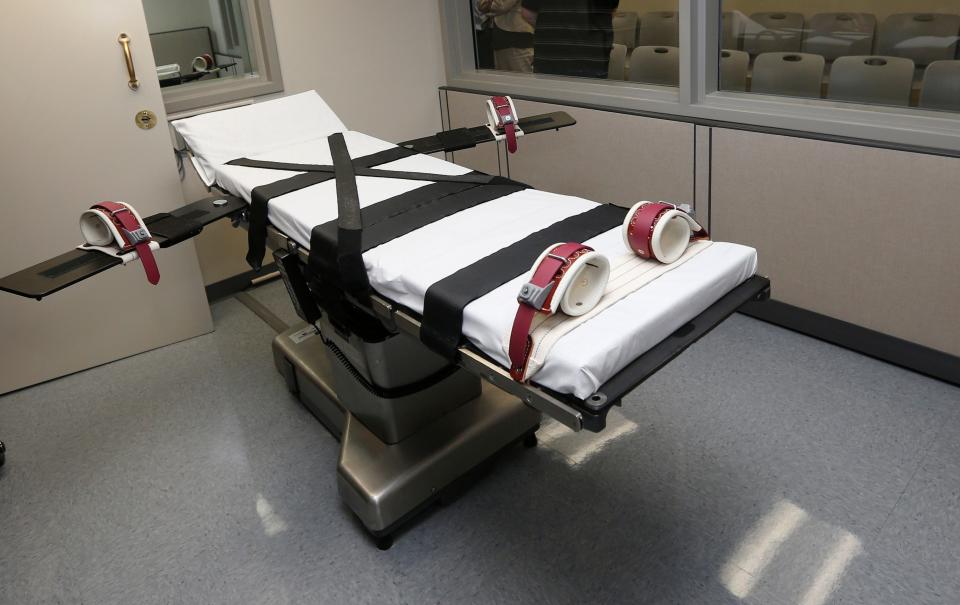Alabama looks to perform second execution of inmate with controversial nitrogen hypoxia
Alabama is seeking to execute a second inmate using a nitrogen gas that became the subject of controversy last month when convicted murdered Kenneth Smith was observed convulsing and gasping for air while being put to death.
Nitrogen hypoxia's use as an execution method had drawn concerns from advocates and death penalty opponents even before it was administered to Smith, causing what witnesses reported appeared to be a drawn-out, painful death. But Alabama Attorney General has insisted the execution was "textbook," and is now making good on his promise that the state would seek to use the method again.

Marshall’s office asked the state Supreme Court on Wednesday to set an execution date for Alan Eugene Miller to be carried out using nitrogen. Miller, 59, has been on death row since 2000 after he was convicted of killing three people during two 1999 workplace shootings in suburban Birmingham, according to Marshall's office.
“The State of Alabama is prepared to carry out the execution of Miller’s sentence by means of nitrogen hypoxia,” the attorney general’s office wrote.
Nitrogen gas for executions? Ohio Republicans pitch new death penalty method
'Execution by suffocation'?
Alabama became the first state on Jan. 25 to use the new method to execute a human after becoming one of three states in 2015, along with Oklahoma and Mississippi, to add nitrogen hypoxia to its approved list of options.
Proponents of nitrogen hypoxia have insisted that the method is a more humane alternative to the long-preferred method of lethal injection. But those who have opposed the method said that in practice, it caused a prolonged death by asphyxiation.
Smith, one of two people to receive the death penalty for the 1988 murder-for-hire plot of a preacher’s wife, survived a previous executive attempt in 2022 by lethal injection when officials could not gain access to his veins.
After the failed attempt, Smith chose nitrogen gas for his execution.
On Jan. 25, he strapped to a gurney and affixed with a face-mask through which the gas was administered. Before he was pronounced dead 22 minutes later, Smith appeared to convulse, gasp for air and shake vigorously for about four minutes after the nitrogen gas began flowing through the mask.
“Nitrogen hypoxia is the wrong name," Abraham Bonowitz, executive director of the anti-death penalty group Death Penalty Action wrote in an email to the Associated Press. "It should be called execution by suffocation."
Inmate executions: This state could be next to use nitrogen gas for death penalty if bill passes
Like Smith, Miller survived previous execution attempt
Officials who advocate for the death penalty hold a much different view.
“As of last night, nitrogen hypoxia as a means of execution is no longer an untested method," Marshall said the morning after Smith’s execution. "It is a proven one."
Since Smith was put to death, more and more death penalty states have signaled their interest in adopting nitrogen hypoxia as an execution method, including Louisiana and Ohio.
If Miller is put to death in Alabama by nitrogen hypoxia, it would be his second execution attempt after Alabama failed to put him to death by lethal injection in September 2022. After calling off Miller's execution when officials were unable to establish intravenous access, Alabama agreed with the inmate's request to use nitrogen hypoxia in the future.
Miller first had sued several state officials prior to the first execution attempt, claiming that their plan to execute him by lethal injection was unconstitutional because he had opted to die by nitrogen hypoxia.
Miller was sentenced to death for the killing of three men in two workplace shootings in Shelby County in 1999. Prosecutors said an employee entering Ferguson Enterprises in Pelham saw Miller exit the building on Aug. 5, 1999, before finding Lee Holdbrooks and Scott Yancy dead inside. At another former employer's site, Miller killed Terry Jarvis.
Contributing: The Associated Press; Evan Mealins, the Montgomery Advertiser
Eric Lagatta covers breaking and trending news for USA TODAY. Reach him at elagatta@gannett.com
This article originally appeared on USA TODAY: Alabama inmate execution with nitrogen hypoxia could happen again

